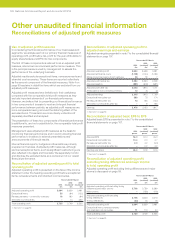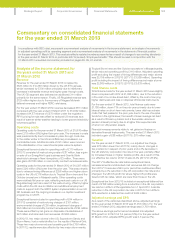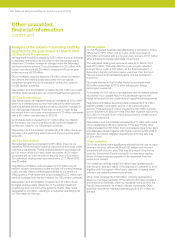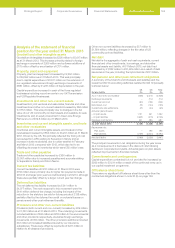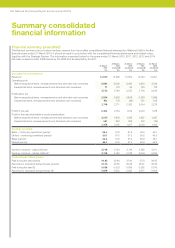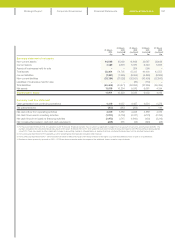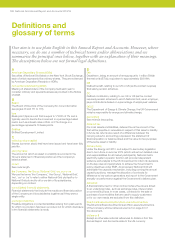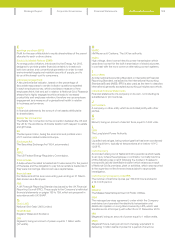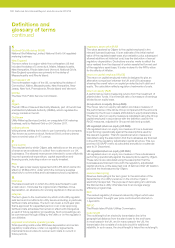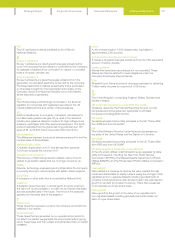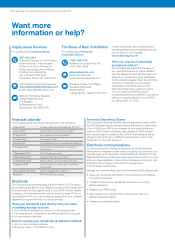National Grid 2014 Annual Report Download - page 192
Download and view the complete annual report
Please find page 192 of the 2014 National Grid annual report below. You can navigate through the pages in the report by either clicking on the pages listed below, or by using the keyword search tool below to find specific information within the annual report.
Definitions and
glossary of terms
continued
regulatory asset value (RAV)
The value ascribed by Ofgem to the capital employed in the
relevant licensed business. It is an estimate of the initial market
value of the regulated asset base at privatisation, plus subsequent
allowed additions at historical cost, less the deduction of annual
regulatory depreciation. Deductions are also made to reflect the
value realised from the disposal of certain assets that formed part
of the regulatory asset base. It is also indexed to the RPI to allow
for the effects of inflation.
return on capital employed (RoCE)
The return on capital employed metric is designed to give an
alternative comparison between the UK and US businesses
showing the overall return on capital provided by both debt and
equity. The calculation reflects regulatory treatments of costs.
return on equity (RoE)
A performance metric measuring returns from the investment of
shareholders’ funds. It is a financial ratio of a measure of earnings
divided by an equity base.
Group return on equity (Group RoE)
The Group return on equity calculation provides a measure of
theperformance of the whole Group compared with the amounts
invested by the Group in assets attributable to equity shareholders.
The Group return on equity measure is calculated using the Group
capital employed in accordance with the definition used in the
RoCE measures, adjusted for Group net debt and goodwill.
US regulated return on equity (US RoE)
US regulated return on equity is a measure of how a business
isperforming operationally against the assumptions used by
therelevant regulator. This US operational return measure is
calculated using the assumption that the businesses are financed
in line with the regulatory adjudicated capital structure. This is a
post-tax US GAAP metric as calculated annually (on a calendar
year to 31 December).
UK regulated return on equity (UK RoE)
UK regulated return on equity is a measure of how a business is
performing operationally against the assumptions used by Ofgem.
These returns are calculated using the assumption that the
businesses are financed in line with the regulatory adjudicated
capital structure, at the assumed cost of debt and that UK taxation
paid is at the level assumed by Ofgem.
revenue decoupling
Revenue decoupling is the term given to the elimination of the
dependency of a utility’s revenue on the volume of gas or
electricity transported. The purpose of decoupling is to eliminate
the disincentive a utility otherwise has to encourage energy
efficiency programmes.
RIIO
The revised regulatory framework issued by Ofgem which was
implemented in the eight year price controls which started on
1April 2013.
RIPUC
The Rhode Island Public Utilities Commission.
route length
The route length of an electricity transmission line is the
geographical distance from the start tower to the end tower.
Inmost cases in the UK, and in many cases in the US, the
transmission line consists of a double circuit for additional
reliability. In such cases, the circuit length is twice the route length.
N
National Grid Metering (NGM)
National Grid Metering Limited, National Grid’s UK regulated
metering business.
New England
The term refers to a region within the northeastern US that
includes the states of Connecticut, Maine, Massachusetts,
NewHampshire, Rhode Island and Vermont. National Grid’s
NewEngland operations are primarily in the states of
Massachusetts and Rhode Island.
northeastern US
The northeastern region of the US, comprising the states of
Connecticut, Maine, Massachusetts, New Hampshire, New
Jersey, New York, Pennsylvania, Rhode Island and Vermont.
NYPSC
The New York Public Service Commission.
O
Ofgem
The UK Office of Gas and Electricity Markets, part of the UK Gas
and Electricity Markets Authority (GEMA), which regulates the
energy markets in the UK.
OnStream
Utility Metering Services Limited, an unregulated UK metering
business, sold by National Grid on 24 October 2011.
ordinary shares
Voting shares entitling the holder to part ownership of a company.
Also known as common stock. National Grid’s ordinary shares
have a nominal value of 1117⁄43 pence.
P
price control
The mechanism by which Ofgem sets restrictions on the amounts
of revenue we are allowed to collect from customers in our UK
businesses. The allowed revenues are intended to cover efficiently
incurred operational expenditure, capital expenditure and
financing costs, including a return on equity invested.
PSA
The 15 year power supply agreement with LIPA which came into
effect on 28 May 2013, under which the Company supplies
electricity to communities and businesses across Long Island.
R
rate base
The base investment on which the utility is authorised to earn
acash return. It includes the original cost of facilities, minus
depreciation, an allowance for working capital and other accounts.
rate plan
The term given to the mechanism by which a US utility regulator
sets terms and conditions for utility service including, in particular,
tariffs and rate schedules. The term can mean a multi-year plan
that is approved for a specified period, or an order approving
tariffs and rate schedules that remain in effect until changed as
aresult of future regulatory proceedings. Such proceedings can
be commenced through a filing by the utility or on the regulator’s
own initiative.
regulated controllable operating costs
Total operating costs under IFRS less depreciation and certain
regulatory costs where, under our regulatory agreements,
mechanisms are in place to recover such costs in current or
futureperiods.
190 National Grid Annual Report and Accounts 2013/14




